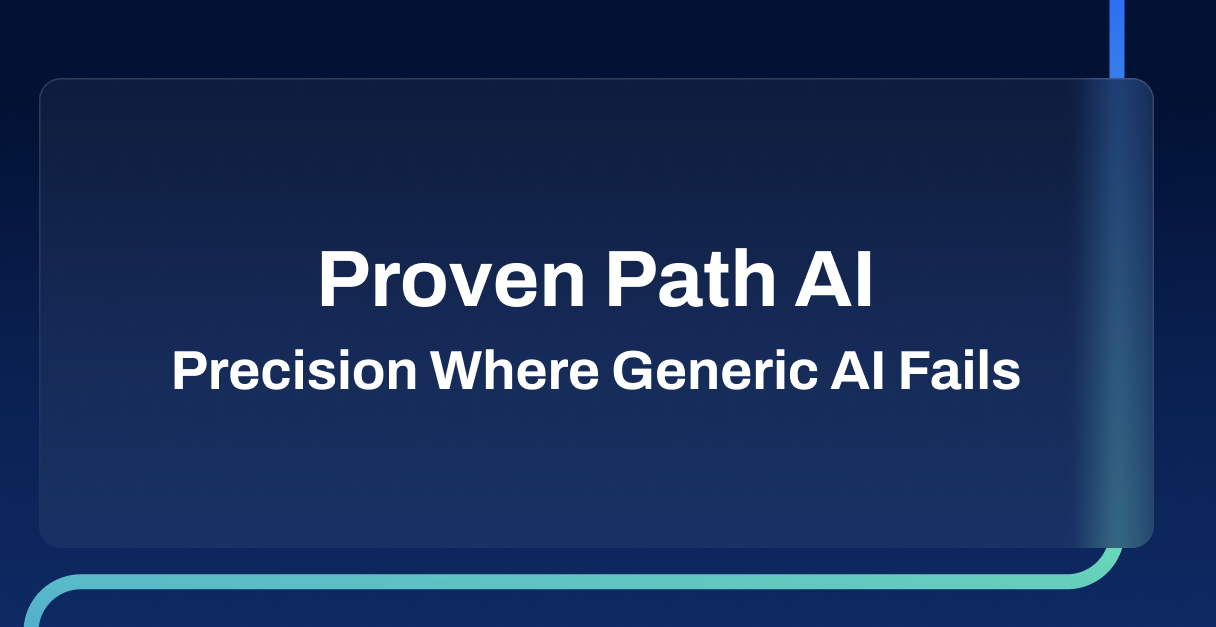Why Probabilistic, "Best Guess AI" Fails in Service

Service leaders are discovering a harsh reality about enterprise AI. The conversational AI that handles customer questions brilliantly becomes dangerously unreliable when technicians need to fix critical equipment.
Multiple studies, including recent data from MIT, suggest that a large share of enterprise AI initiatives fail to deliver meaningful ROI. That aligns with what we’ve seen at Neuron7. Despite billions invested, too many projects stall at the proof-of-concept phase or deliver limited impact.

Here's why "Best Guess AI" systems like RAG and copilots fail in complex technical environments:
1. Critical Safety and Compliance Failures
Probabilistic (Best Guess) Failure: In high-stakes environments like medical devices, even plausible-sounding AI guidance must adhere to strict regulatory guardrails. Without risk-aware routing, probabilistic systems may synthesize steps that don’t follow approved procedures, creating safety concerns.
Deterministic (Proven Path) Solution: Neuron7 recognizes when a query requires exact adherence to regulatory procedures and routes to deterministic pathways based on approved schemas and documented case histories, enabling consistent compliance with approved procedures and safety protocols.
2. Inconsistent Responses to Identical Technical Issues
Probabilistic (Best Guess) Failure: When multiple technicians encounter the same error, probabilistic systems can produce inconsistent responses depending on prompts or context—especially when issues are complex or have subtle variations.
Deterministic (Proven Path) Solution: Neuron7's agents detect when an issue matches known patterns and automatically route to proven, repeatable procedures. The same hydraulic pump failure in industrial equipment always triggers the validated 7-step diagnostic sequence that achieved 98% success rates in previous cases.
3. Knowledge Base Gaps Create Dangerous Hallucinations
Probabilistic (Best Guess) Failure: When RAG systems encounter technical scenarios not well-covered in their knowledge base, they generate confident sounding but incorrect guidance. A telecom technician might receive fabricated specifications for fiber optic splice procedures because the AI fills knowledge gaps with plausible-sounding fiction.
Deterministic (Proven Path) Solution: Neuron7 recognizes when queries fall outside reliable knowledge boundaries and routes to structured diagnostic procedures or escalates to human experts rather than hallucinating dangerous guidance.
4. Complex Multi-Step Procedures Get Fragmented
Probabilistic (Best Guess) Failure: Manufacturing equipment repairs requiring precise sequential steps get broken into disconnected responses. A copilot might provide step 3 of a calibration procedure without ensuring steps 1-2 were completed correctly, leading to equipment damage or safety hazards.
Deterministic (Proven Path) Solution: Neuron7's agents recognize complex procedural workflows and route to complete, validated sequences that maintain proper dependencies and safety checkpoints throughout the entire repair process.
5. Domain Expertise Requirements Exceed General AI Capabilities
Probabilistic (Best Guess) Failure: High-tech hardware troubleshooting requires understanding of interdependent systems, device specifications, and log data that generic AI cannot reliably synthesize. A RAG system might miss critical relationships between failures that experienced technicians know instinctively.
Deterministic (Proven Path) Solution: Neuron7 captures expert technician knowledge in structured decision trees and proven pathways, ensuring complex domain expertise is preserved and consistently applied rather than approximated through probabilistic generation.
The Key Insight: Probabilistic AI excels at conversation and information retrieval, but complex technical service requires the certainty and consistency that only deterministic procedures can provide. Neuron7’s intelligence layer can work independently or alongside popular CRM AI tools like Agentforce, adding the domain-specific judgment to choose the right approach for each situation.
The Path Forward: Best Guess + Proven Path AI = An Agentic Service Engine
The solution isn't abandoning conversational AI. It's building systems smart enough to know when to use Best Guess AI versus Proven Path AI. A service resolution path finder if you will.
When a technician asks, "What are the symptoms of hydraulic pump failure?", Best Guess AI works great. When they ask, "How do I replace the hydraulic pump on Unit 247B?", you need the exact procedure that's worked in 500+ previous cases.
This represents the next evolution in service AI. It's not about choosing between approaches - it's about having systems intelligent enough to choose the right approach for each situation.
MIT found external partnerships achieve 67% success rates versus 33% for internal builds. We didn't achieve 90%+ resolution accuracy for Fortune 1000 clients by chasing the latest model. We did it by solving real workflow problems with AI that knows when to search and when to follow proven procedures.
The organizations that understand this distinction will build sustainable competitive advantages. Those that don't will become part of that 95% failure statistic.
Complete Your Service AI Evolution
Explore The Ultimate Guide to AI for Complex Service and see how the right Intelligence Layer can help you scale resolution, not risk.
Discover how Neuron7 works in your service environment.




